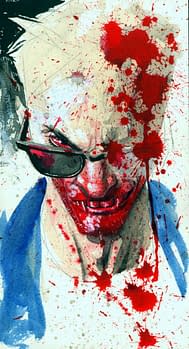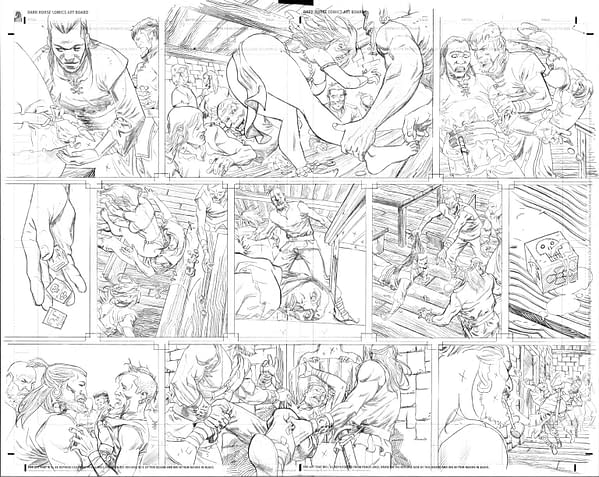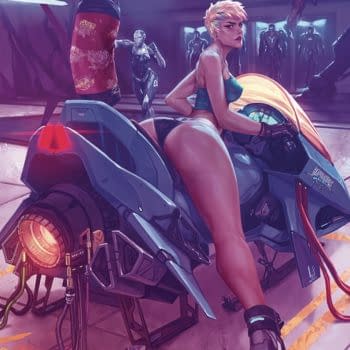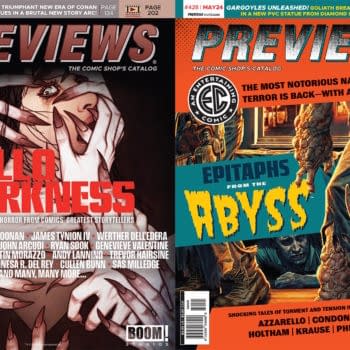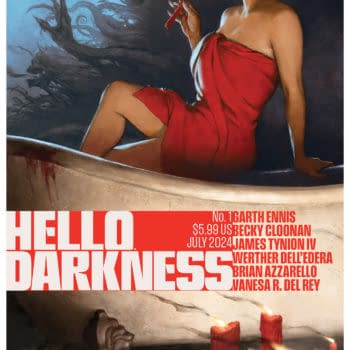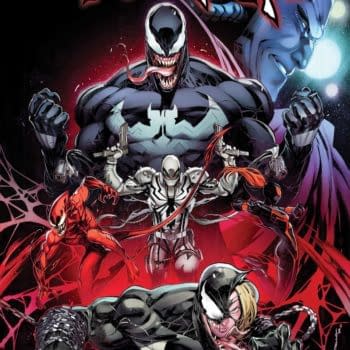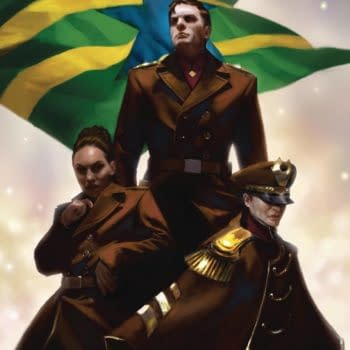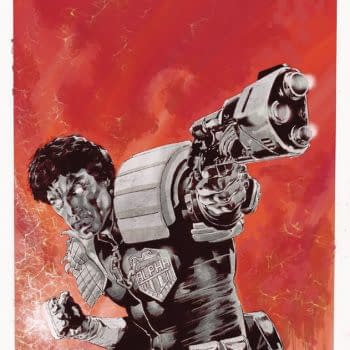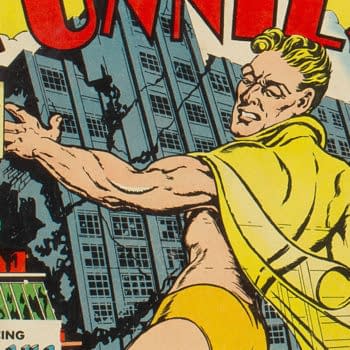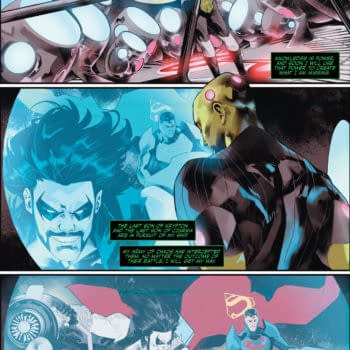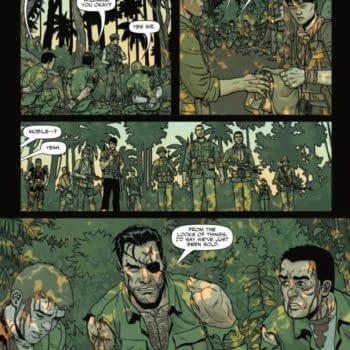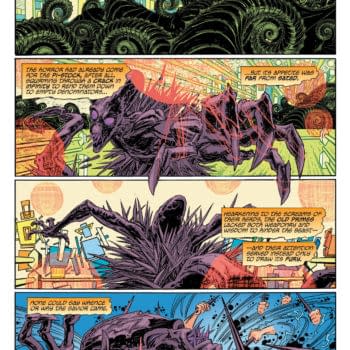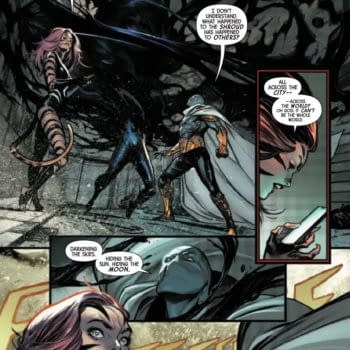Posted in: Comics | Tagged: dc, mike hawthorne, vertigo
Mike Hawthorne And Fulfilling St Michael's Promise, The Graphic Novel That Vertigo Forgot
Travis Ellisor writes;
I first saw Mike Hawthorne's art about ten years go when he drew Three Days in Europe and an arc on Queen & Country. I was impressed, not just with his style, but with his gift for storytelling. Since then Mike has drawn a great variety of comics and even written a few. He's currently a rotating artist on Deadpool and he took some time out of his busy schedule to talk about his art and his career (so far) in the comics industry.
I don't think I had just one moment where I fell in love. More like a bunch of moments that accumulated. At the time I was running around my neighborhood wanting to be a graffiti artist. Then a friend gave me a copy of Judge Dredd, which I was just bowled over by. Then another friend showed me those big magazine sized Conan comics, which split my imagination open. Eventually I made my way to a local book store, then comic shops, where I found the X-men, Heavy Metal and oddball comics like Warlock 5. Then it hit me that I wanted to draw these crazy books with pictures AND words.
So when did you start drawing?
Oh, man… you might as well ask when I started using shoes. I can't recall NOT drawing! :-)
And at what point did you decide that you wanted to be a professional artist?
The moment it hit me that you COULD be such a thing. I recall reading my first issue of The X-men, back when Silvestri was drawing it, and it just clicked for some reason. People were paid to draw, and I could be one of those people. It was an epiphany!
I went on to take every art class I could in high school, attended the Pennsylvania Governor's School for the arts, then went on to study painting at Temple University's Tyler School of art, all so I could be a better comic artist. Little bit of overkill, I know.
Speaking of art education, aren't you teaching now?
Yes, I am. I'm teaching a class on Concept art at the Pennsylvania College of Art and Design. I'm part of the illustration program there, and it's going great. I'd lectured there for a few years now, and was invited to take part in their 24 hour comic day event "Illustration 24". While there, the head of the department asked if I'd be interested in teaching a class. It was kind of bad timing, since I'm juggling several projects and need every minute of studio time I can get. But we managed to work it out, and all is good. Honestly, had I not gotten to know the school a bit by lecturing there I'd have passed up the gig. But I've grown fond of the place, and the Illustration Department, and thought it would be cool to be a part of.
Very cool. Now back to the past – how did you break into comics and what was your first published work?
I started self publishing my own book, Hysteria. I did everything; art, story, letters, design, EVERYTHING. I even wrote my own solicitations, and drove the thing into Diamond to make it into Previews. Crazy times, and I lost all the money I put into it, but I learned a hell of a lot about making comics.
As far as "breaking in" my first actual gig was with Dark Horse. It was through Matt Wagner, who I got to know because we shared an illustration professor in the Philly area (albeit around 15 years apart). Matt became a mentor of sorts and asked me to draw a short for Grendel Red, White and Black (which was reprinted recently in the first Grendel Omnibus). I'll be forever grateful to Matt. The man is a prince. Love that dude.
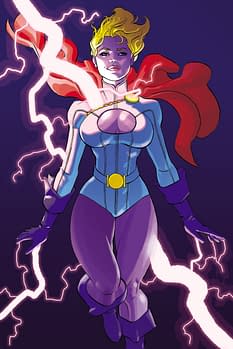
Dude, thanks! I had plans to finish One Man Gang as a webcomic, but the numbers weren't there to support it. Sucks, but such is life.
After the Grendel story you got a gig on Three Days in Europe, written by Antony Johnston. How did you get that gig and what was that experience like?
Again, it was Matt that introduced me to them . . . if I'm remembering correctly. Three Days is a favorite of mine. I loved working with Antony, and I think he's terribly underrated. We're still friends to this day, and when the stars line up we'll work together again!
Because the book is a romantic comedy I knew we had an uphill battle with the comics market. I decided to approach it as if it were going to be someone's first comic. I wanted to craft the thing so that even uninitiated comic readers could dive in and enjoy it. Most of it is drawn in a simple 6-panel grid. I did anything I could think of to make it simple to read, but still keep the charm of the story intact.
So, even to this day, I can hand it to any of my non-comic reading friends and they instantly connect with it.
I actually knew about Antony and this book because of the original Warren Ellis forum way back when.
Ahh, really? That's cool.
I discovered your art because of that book, but I think that I truly became a fan during your arc on Queen & Country. What can you tell us about that job?
Man, Queen & Country was big for me artistically. I turned down an offer from two major comic companies to do it. I read it when Greg started it with Steve Rolston and was hooked. I wanted to draw it so bad, and specifically told James at Oni that I wanted a turn at bat and that I'd wait no matter how long. I got my turn and just loved the hell out of the script. Greg's novelist roots come through in his work and his scripts are enjoyable as is. No pictures needed.
I'm both very proud of Q&C, but a little ashamed too. The book had fallen off track a bit schedule wise and I had to help catch it up. I also had another gig at the time. So I had to run at times when I wish I could have strolled, you know? It's one of those books I wish I could have loved up more. I'd kinda like to revisit it to redraw some parts if only for my own enjoyment.
That book is very close to my heart.
I'd love to see you draw another arc on Queen & Country if Greg Rucka ever gets it going again.
Yeah, it would be cool to revisit.
Anyway, also around this time you drew a couple of issues of a Terminator comic where you were inked by Rick Remender. How did you get hooked up with that job and with Rick?
I actually knew Rick from before that. We'd already been friends when we teamed up on Terminator. So it was a pretty natural fit. I know he's famous now for his writing, and deservedly so, but I always loved Rick's art. We were a good team . . . well, besides the fact that I was a terrible penciller. By that, I mean that I'd never worked with an inker before and wasn't aware of my eccentricities on the page, the odd little blips in logic that I usually fixed in the inking stage. I just wasn't aware of my own process, and how much I edited my pages as I went along from layouts to pencils to inks. I'm sure Rick looked at some of those pages and thought that I was high when I drew them! But working with Rick, seeing how he handled my shitty pages, it taught me a great deal.
Perhaps the biggest problem was that we had almost no time to really work on that book. We had to double time it to get it out in conjunction with the movie. Really grueling schedule. If I remember correctly, between that and Q&C, I was drawing the equivalent of two books each month!
It's kind of sad, really. Between the comic being in the T3 fan magazine, newsstands, and comic shops, the numbers were pretty high for that book. I wish I could have done a better job on it.
I think I discovered Rick Remender's work as an inker first before I read any of his writing. Anyway, working with Rick must have been a good experience, because you guys collaborated as an art team again on Ruule: Ganglords of Chinatown, which I thought was one great-looking book. Tell us about your time working on that series.
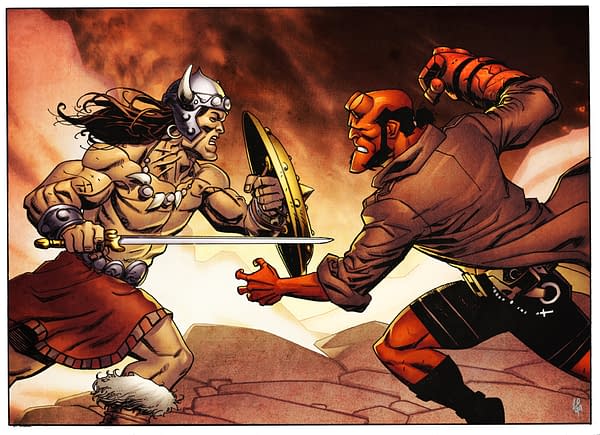
Your first work for Marvel was Machine Teen, with Marc Sumerak on writing. That was a very good book which never had time to find its audience, in my opinion. So how did you end up working for Marvel and what did you learn from that experience?
Well, Machine Teen was an odd time for me. After rushing through one book after another, I was just so burnt out when I took the job. I needed a change, but I wasn't sure what it was. But then the change sort of found me. Or rather, two changes.
First, I saw that I was becoming TOO professional. Before comics, I'd done a lot of design and advertising work, and sort of trained myself to try and make the client happy. That's fine, but in comics I think it's not always a good idea. You have to learn to hold on to certain ideas if you feel strongly enough about them. We were creating a new character, and during the design process I took notes from the editors too literally. Like, if someone said "I wonder if he should look more like this?", I just changed it without seeing that it was a question. I was trying too hard to make the client happy, when what the client wanted was to discuss possibilities. I was just a little too naive to how the business worked because I didn't have much experience with it. I'd been a poor kid all my life, and now people were paying me to draw for them. I was terrified I'd fuck up somehow and go back to eating in soup kitchens.
Second, I learned to put my work in its place. I don't want to go into any details here, but something happened to one of my children that almost broke me. I remember I just wanted to quit the book for a while, but felt I couldn't. I talked to the editor and asked for someone to help out with inks so I could still meet the deadlines. I was going through this disastrous event in my life and I was still worried about my book. Worried about it being late, and about disappointing fans.
So Machine Teen was a huge turning point for me. You could draw a line after it and divide my mentality towards my work in two parts. Post-Machine Teen I was a different man. I decided I'd take every new project being ready to walk away from it. Ready to quit it. I'd still be as professional as always, but I wouldn't sacrifice myself for the book. If an editor asked for something I felt I couldn't do, I'd just politely decline instead of trying to fit their needs somehow. I'd been doing that, sacrificing myself for these books, and had no one to blame but myself. I was never really asked to. I just did it blindly. Stupidly.
After Machine Teen, you drew a bunch of short projects and fill-ins with more Hysteria, the mystery series Umbra, a short western story for The Wicked West, a couple issues of The Exterminators at Vertigo, and even some Tales of the Teenage Mutant Ninja Turtles. Did you enjoy drawing such a variety of different comics and do you feel it strengthened your work not sticking to just one genre?
That was me finding my equilibrium. My head still wasn't right after our little family tragedy. I had let my guard down and someone I loved was hurt, so I didn't trust myself anymore. My work is me, so me not being well meant my work wasn't well either. I needed to get right, and the only way I could think of that was to keep moving, even if that movement wasn't forward. Even sideways movement felt okay.
There was another book in there that I worked on which no one saw, Sturgeon River. That was a more personal project done with UMBRA writer Steve Murphy. It was yet another genre, a Bildungsroman. I took any gig that was short, or that allowed me to stretch, turning down anything that felt too involved.
Looking back, it's kind of like when you see a long married divorcee who acts like a Playboy just because he thinks he needs that to be happy. Of course, it's all bullshit, but it got me through that weird time in my career and life. After a while of that I saw I wanted to be committed bigger projects again. You started to see longer runs from me, like thirteen issues of The Un-men, or the year on CONAN.
With all that said, I did enjoy drawing a variety of books. I made great strides during that time. I'm still using techniques now that I developed during those short works. It's very much like a novelist who first hones his craft with short stories. I recommend any new artist or cartoonist give it a shot.
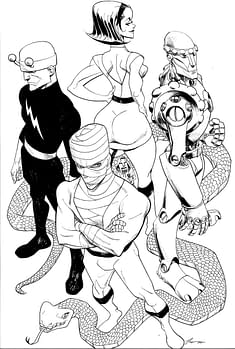
Tony Moore introduced me to his editor at Vertigo for the Exterminators, Jon Vankin. I ghosted some layouts for an issue for Tony, and then an issue that John Lucas drew. Eventually Jon asked if I'd like to draw my own run. Simon Oliver was writing some great, insane stuff. I loved the book, so I agreed.
Jon then asked if I'd look at this pitch they had okayed based on the old Swamp Thing villains. I read the pitch and was absolutely sold. You don't have to ask me twice if I want to draw a talking brain on a hand!
Thing was, it was an ongoing and I grappled with the idea of being tied down to one book. I loved the story so much, and John Whalen is such a brilliant guy, but I wasn't sure that I wanted to give up my freedom. I was enjoying bouncing around, doing all kinds of stuff that I didn't have to commit to long term and loving it. Even the books I was doing layouts on, some as a ghost, I dug. I liked jumping in, breaking up some storytelling problem, then bouncing out. I had to give up that freedom if I was to take on an ongoing.
In the end, the book was too much of what I loved to pass on. I had to do it, and I'm so glad that I did. I got to build a Vertigo series from the ground up, and that was a dream for me. I loved Vertigo and was thrilled to be part of it. I think we launched with books like Scalped, Air, and the cool graphic novels they were doing and I felt excited about all of it. I designed all of those weird characters, either from scratch of from the early Swamp Thing stuff that Bernie Wrightson did. I was absolutely thrilled with it all. Just the book I needed to get back into longer form comics.
I was really disappointed by the cancellation. There was nothing on the stands like The Un-men. Although Vertigo owned the book, they didn't try to dump us and chase a new creative team to see if they could get sales up. The book was us, John and I. I respect that they treated it as such.
I remember Un-Men getting a lot of positive reviews at the time, but it just did not seem to translate into sales. Sadly, this seems to happen far too often.
Yeah, we got a ton of love for the book. If you read it, you loved it. If I recall correctly I think there was a little stink on the series because some Swamp Thing fans were angry that book was cancelled, but other than that we were well received.
Okay, when IDW started publishing G.I. Joe comics, they had Larry Hama write a brand new origin for the team in G.I. Joe: Origins, and you got to draw it. Were you a Joe fan and what was it like working with Mr. G.I. Joe himself, Larry Hama?
You know, I was a huge fan of the toys as a kid. But I admit, I never read the comic. I think it kind of made it perfect for me though, since I could approach a revamp with no baggage to carry.
I knew almost nothing about Larry. We actually didn't hit it off right away, which was totally my fault because I was a smart ass.
But it was all Roadblocks fault! I was just beginning to work with Larry, getting to know him, and he's this really professional guy. No joking, get to work. You know? Kinda like Clint Eastwood in Heartbreak Ridge, and I'm Mario Van fucking Peebles. We're e-mailing back and forth, Larry, me and the editor, about the book and Larry sends this line of dialogue from Roadblock. I sent it back, having added another line to it making it rhyme, with this note saying "Didn't you mean for him to say this?"

But I hadn't ever really read any of the old JOE comics, and wasn't taking seriously the fact that Larry and IDW were doing this more military procedural take on the series. Hence my smart ass joke. Which Larry swatted down. I laughed it off and was ready to push the Roadblock joke farther and farther, then started to see that I was being a jackass. I made myself look at the series with his eyes, and not my own. I started to get that it was not a comic about a toy line anymore. It hit me how much story he'd crammed into this thing, and I had to respect that and start to behave.
We got to know each other after a while, and I began to respect the man immensely. Did you know he was an assistant to Wally Wood? How crazy is that?!
Yeah, Larry has a very interesting history. He should really write a book about his life at some point.
You ain't kiddin'.
You hooked up with Rick Remender once again when you drew some great-looking issues of one of my favorite books, Fear Agent. How was it, telling the final story of Heath Huston?
It was odd. I've known Rick and Tony a long time, and recall when they were first developing the series. I was with Rick in San Diego when he had printed up these posters to promote the original series and was handing them out to fans. Hell, I'd even pitched in with layouts for Tony in the first arc. So I'd been around since the beginning, more or less. It warmed my heart that they trusted me enough to pitch in at the end. Broke my heart too, because it was ending.
People talk about collaboration in comics, but these guys really do it. I remember Rick calling me to ask my opinion on some story ideas, and I was like "Dude, I just draw the pictures! You're the writer, you're not even supposed to care if I HAVE an opinion!" :-)
Imagine my surprise when he listened and we talked about how to use it in the comic! Crazy. Like, the book was more important than any ego. We worked together beautifully. I'd do rough pencils, then John would partially ink them, Tony would come in and ink some more (usually the faces). Lee would bang in the colors with notes from Tony, Rick, or whoever. It was like a mini animation studio where the art is tossed around and the team is just focused on the final product, not their individual credit.
I think we could do that because we'd all worked almost every level of a comic. I'd written, drawn, lettered, etc. Tony and John are artists, not "pencillers" or "inkers". Hell, Rick is an artist. No one could just lean back on their job title and say 'you take care of the rest". We all pitched in because we could! Hell, I'm kinda surprised Rick didn't draw some of it!
I could work like this because these guys are all close friends and I respect them all. Normally I'm so tight with my work that I hate handing it off even to a letterer, much less an inker or colorists!
Well, I am definitely looking forward to seeing your arc on the book on those oversized pages when the second Fear Agent Library Edition comes out later this year.
Me too! I don't think I've ever seen my stuff printed oversized.
Well then we can both look forward to it! Anyway, let's talk about Conan: Road of Kings, where you got to work with the legendary writer Roy Thomas, and you were inked by the almost-legendary Joltin' Johnny Lucas. How did you land that gig and what was it like getting to draw so many sword fights, scantily-clad women, zombies and other monstrous creatures?
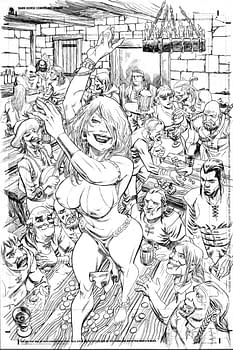
Honestly, it was much more work than I thought. I'd gotten into comics loving those old Savage Sword magazines and so getting to draw Conan was a thrill. But, it hit me fast that I'd never drawn anything like it. I'd never drawn fantasy before. I just never got into the genre for whatever reason, so I had a ton of homework to do just to begin the series. I don't think I ever researched a book more heavily, save perhaps Queen & Country.
After Conan you did something completely different yet again with Oms en Série. How on earth did you get involved with this book and do you speak French?
HA! It was a long time in the works, actually. Years ago I pitched a book to a smaller French publisher through a good friend of mine; an American artist ex-pat in France named Dan Christensen. (Coincidentally, He's got a book coming out soon with Jamie Rich at Oni). That book fell through, but I got the bug in my ear and could get it out. I'd talk to Dan about it from time to time and he suggested that I contact a writer named JD Morvan, who's a big name in France. He did a short Wolverine story for Marvel a while back, and tons of beautiful French "BDs". We hit it off and JD asked about working together on a few books, the first of which was Oms en Serie. We did a graphic adaptation of the Stephan Wul novel of the same name. Great, weird, stuff and perfect material for my first BD. I wanted to try to channel Moebius and this was just the book for that. Of course I can't come close to the master, but a fella can try!
I do speak a little French. I'm not comfortably speaking it, and need to work on my vocabulary, but I can do basic stuff. I'm more fluent in Spanish, which complicates things when studying French. I tend to want to pronounce French words like Spanish words!
Yeah, I'm way better with my Spanish than my French, too. I hope your Oms en Série adaptation gets an English translation in the future, so I can properly read it.
That's the goal. A publisher here in the United States is already interested in it, so fingers crossed.
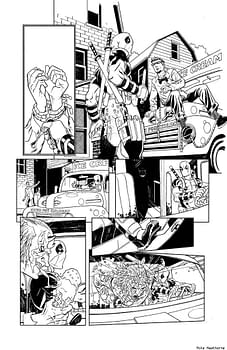
It fell into my lap! Honestly, I didn't see it coming. Tony Moore was loving the book up real proper, but had to roll after issue 6. They asked him who he thought could take over, and he said me! I was kind of shocked, because I'd been out of American comics for some time. Hell, other than some covers for Mass Effect and Star Wars, I've been gone since Conan. So I was kind of in that mind set and wasn't expecting the call. Hell, I hadn't worked for Marvel for 7 years, and hadn't been showing my stuff around there. So yeah, thanks Tony!
Deadpool is perfect for my first superhero comic. Gerry and Brian are brilliant too. They've got great jokes in there, but they never chase the humor, you know? Just feels natural. There is some real pathos too. We get to see that this is a dangerous guy. Not just crazy, but a messed up hazard of a human.
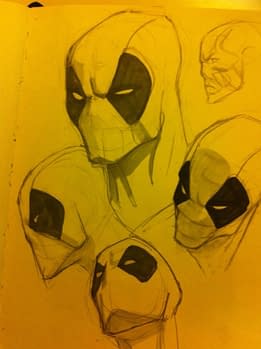
You're right, and these two guys are perfect for it. What I think is great is that they're not just using Deadpool as a vehicle for their humor; they're trying to write humor that fits the character. They're writing Deadpool's brand of humor, you know?
There's one last project I want to ask you about – St. Michael's Promise, the unpublished graphic novel you wrote and drew originally for Vertigo. What is that story about and do you mind telling us why it hasn't been published yet?
That, sir, is a long story. The story is roughly autobiographical, but really that's just a tool to tell the story of my mother's coming here from Puerto Rico and how she never quite fit into American society. It's about what it's like to be Puerto Rican in America, to be a nationality with no true nation. It's very much in the same vein as 100 Years of Solitude or The Brief and Wondrous Life of Oscar Wao.
I began writing the book around the time I was drawing The Un-Men. The seed grew out of a discussion I had with my editor one night over diner in New York. We were talking about Diaz's book and I mentioned kind of off hand how as child a curse had been placed on me, and how that lead to my mother rushing me off into hiding. He said something to the effect of "write that!", so I did and he loved it.
I was to be part of this graphic novel initiative Vertigo was launching, some of which made it out before the big upheaval at DC with The New 52. Vertigo was changing fast, and my book was sitting and sitting. Finally I asked for something to happen, and since the GN line was basically gone they decided to let the book go.
Now I have this finished book, with years invested in it. It took about one year and nearly a dozen revisions to write, and at least that much to draw. Because of that I'm not eager to let it go. So there are no plans right now for it.
Hear that, publishers? Get in touch with Mike if you want to publish a cool graphic novel!
Okay, now tell me about your art influences. I've seen your style vary a bit from project-to-project, always to better suit the book you're working on, which I think is pretty cool. Who and what have influenced your art?
Yeah, you're right. I change my style to fit the book. Because of that I think my influences change often, but there are some that stick around. Moebius, for sure. Jordi Bernet. Alex Toth. Katsuhiro Otomo. But new people come in all the time. I love Kim Jung Gi. I love Claire Wendling. I love Ron Wimberly. I love Olivier Vatine. I'm kinda easy I guess!
I think each book has a list of influences. For instance, with my French book "Oms en Serie" three big influences are Moebius, Frank Stella, and Frank Gehry. So the list of my influences grows with each book.
I can see that. Anyhow, tell me what your work processes are like, both when you are drawing for another writer, and when you are both writing and drawing yourself.
It's fairly straight forward when working with a writer. I just try to adapt to them, make their story work as well as possible. Full script or plot style, doesn't matter much. You still have to figure out the visual problems. What's fun is reading what they come up with.
When working on my own stuff, I tend to be more fluid and visual. When I did Hysteria, I often had no script, but rather a rough plot which I storyboarded into a visual script of sorts. I did write a full script for the last book of mine I drew, a graphic novel that was going to come out through Vertigo. But that was more for the editor than me. They needed to read something, not just look at pictures!
The only writer I ever worked with that did layouts instead of scripts was Harvey Pekar on an issue of American Splendor. That was a treat man! I got these crazy scribbles on rough layouts for the script, and he said just go nuts and make it work even if I have to add pages. That was pretty rad.
I bet that working with Pekar is an interesting experience.
Oh, absolutely. I wish I could have worked with him a little more, but unfortunately we all lost out on his unique brand of comics.
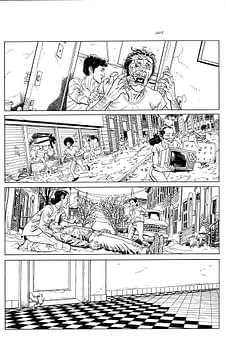
Wow . . . well, it's kind of all over the place right now. Pencils are straight forward, but inks are less so. I switch it up quite a bit nowadays. I use anything from quills and sable hair brushes to Japanese brush pens.
What characters (besides your own) would you like to work on someday?
When you take out my own, it's kind of hard to pick. At one time I thought it would be cool to bring back X, which Dark Horse eventually did anyway.
I'd also say Hellboy if Duncan Fegredo wasn't so perfect for it. And now that Mike Mignola is drawing him again, what's the point?!
Man, I guess it would be a tossup between my friend John Griener's "Skullface" and Matt Fraction's "Casanova", though I doubt I'd make him sing the way Gabriel Bá and Fábio Moon do.
Oh, and Wonder Woman and She-Hulk.
What was the last really good comic that you read?
Hmmm . . . probably Scalped, which I just finished (been too busy drawing, and had a backlog of issues to read). God, what an accomplishment that book was.
I have GOT to finish reading that series at some point! Anywho, thanks for talking with us, Mike! Now everyone go buy Deadpool and check out Mike's latest art!
Mike Hawthorne can be found online at his blog, Twitter, Tumblr and deviantART.


